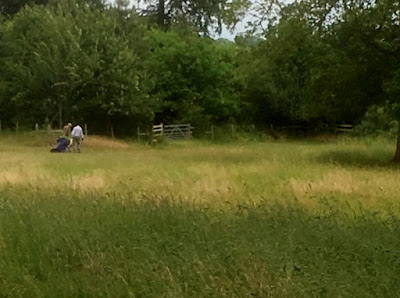Aeons ago, WCM was where WGG started: with a
major project to bring into public use – and improve the biodiversity of – the
pond area. Today, Green-Gymmers’ main
task was one which simply never arose in the early days, to clear the meadows
of a noxious plant which first made its appearance on site during a
particularly damp year.
So, weeding again:
“Hmmm. Woody Nightshade (for some of us) last week, Hemlock next. I’m detecting a pattern.”
Part of the pattern was that target acquisition
presented a bit of a challenge. First,
instruction in positively identifying the species in question. Then, making out green on green, or spotting the spotty stem. “We are now all experts in Hemlock spotting.”
Then it was just a matter of wielding tool of
choice (“You can go with this; you can go with that”) and being thorough
in disposal of cuttings – also hand-care during and after.
At least it was dry underfoot. Yes, we are well aware the land very
much needs more moisture, but from PoV of volunteers moving vegetation this
morning, it was good that rain held off until the afternoon.
Inevitably there were a few ‘odd jobs’ as
well. One was to scythe thistles across
the site. As in previous years, thistles
were thickest where Wallingford Castle excavations had taken place.
As you will have seen from the photographs, at
this time of year WCM is a shared space: between humans and livestock. Members of the public can visit year-round; but
in the summer months we engage in an interesting co-existence exercise with a
small number of (peaceable) cattle which are put out to graze, but are also
very keen on ‘helping’:
They did point out one job for us. At first light yesterday, an off-duty
Green-Gymmer out for a walk noticed that one of them had learned how to operate
the side gate from Upper to Lower Meadows.
We know they are smart animals, but it was quite amusing to see a steer deftly
push against the handle with the side of the neck, then neatly swing the gate
open with the shoulder, trot through, and set about cropping the greener grass on
the other side of the fence.
On closer inspection it became clear that the
creature need not have gone to the trouble of very carefully using the handle. For whatever reason, fittings had slipped out
of alignment. [Caused by posts
shifting as they and ground dry out? – Ed.] The result was that it would not have taken
much of a push – by livestock or human visitor – to get the gate to swing
forward anyway, without releasing the latch:
Another wonder was why the other steers remained
the other side of the gateway, just playing with the side gate: opening and
closing it, but not walking through to the lush pasture in the meadow below. Naturally, as soon as human observer took
camera out of pocket, play stopped:
Off-duty Green-Gymmer had, therefore, suggested
that while volunteers were on site, they might have a go at fixing the gate. Or at least investigate possibilities of mechanism
being adjusted so that the latch engaged properly. “Well that will spoil the cows’ fun,” was the
instant response from our session leader.
Followed by: “I am sure we could have a look at it.”
So they had
a look ... and fixed it. At least we
hope so. This was the solution they come
up with:
It will be
interesting to see over the next few days what the bovine riposte will be.
















No comments:
Post a Comment